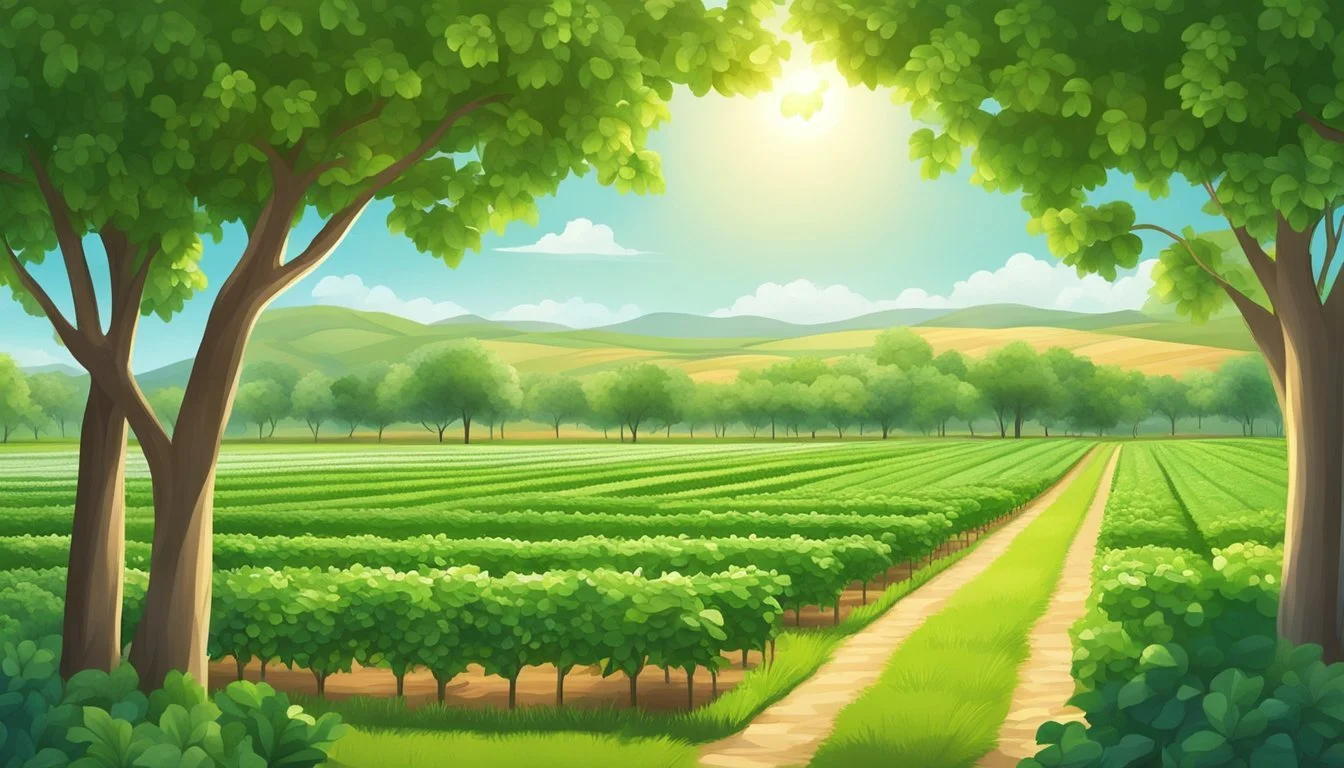New Hampshire Seasonal Fruit & Vegetables in June
Your Fresh Picks Guide
This Article is Part of our New Hampshire Seasonal Fruit & Veg Calendar
June in New Hampshire is a vibrant time for produce as the state's farms and gardens begin to offer a bounty of fresh fruits and vegetables. This period is marked by the transition from the cool, tender offerings of spring to the more robust flavors of early summer. Strawberries, one of the first fruits to herald the warm season, reach their juicy peak, and local farmers' markets display these red gems prominently.
Vegetables also take a turn for diversity during this month. Greens like lettuce and spinach are still abundant, but the warmer weather introduces a greater variety like beets (how long do beets last?), radishes, and peas, which are now becoming ripe for harvest. With the soil warmed up, even the first batches of zucchinis (What wine goes well with zucchini?) and summer squashes make their debut, providing a fresh, seasonal variety to the local cuisine.
Incorporating these seasonal items into meals not only ensures peak flavor and nutrition but also supports the local agricultural economy. Seasonal eating is rooted in the cycle of produce availability throughout the year in specific regions, and in New Hampshire, June's selection is a testament to the state's rich and fertile lands.
Exploring New Hampshire's Seasonal Produce
In June, New Hampshire's seasonal produce reaches a vibrant turning point, offering an abundance of fresh, locally grown fruits and vegetables. This period marks a time when the climate and seasonal shifts significantly influence the harvest.
The Importance of Seasonality
Shopping for seasonal produce means enjoying fruits and vegetables at their peak of freshness and nutritional value. For New Hampshire residents, this practice fosters community support for local farmers and reduces the environmental impact associated with long-distance transportation of goods.
Climate Influence on Harvest
New Hampshire's climate dictates the start and end dates of the growing season. The state experiences a colder climate than some of its southern neighbors, which influences the types of produce that thrive. In June, the soil has thoroughly warmed, and the threat of frost has typically passed, allowing a diverse array of crops to flourish.
June's Unique Position in the Growing Season
June stands at a crossroads in New Hampshire's growing season, where late spring produce lingers and early summer fruits and vegetables emerge. Below is a table of some of New Hampshire's freshest June offerings:
Vegetables Fruits Lettuces Strawberries Spinach Radishes Peas Beets Green onions Cucumbers
These selections represent just a portion of the local harvest available during this time. Consumers can take advantage of the season's bounty at farmers' markets or through community-supported agriculture (CSA) subscriptions.
June's Seasonal Vegetables in New Hampshire
June marks a time of plentiful harvests in New Hampshire, with gardens yielding a variety of fresh vegetables. From leafy greens making their vibrant appearance to root vegetables ready for harvest, residents can enjoy a bounty of fresh produce.
Leafy Greens Availability
In June, gardens in New Hampshire are rich with a variety of leafy greens. Kale and lettuce are abundant, with their peak availability offering fresh and nutrient-dense options for salads and side dishes. Gardeners and shoppers can expect to find:
Kale
Lettuce
Spinach
The availability of these greens is at its prime, and they are ideal for adding a fresh, crisp dimension to meals.
Root Vegetables Harvest
Root vegetables in New Hampshire begin to flourish in June. Harvests typically include tender beets and carrots, which can be enjoyed raw in salads, roasted, or boiled. Root vegetable crops ready for June harvest:
Beets
Carrots
These vegetables are known for their sweetness, which intensifies when cooked, and are a staple in early summer cuisines.
Boosting Gardens with Cruciferous Vegetables
Cruciferous vegetables thrive in the cool beginnings of summer. Cabbage and broccoli are garden favorites known for their health benefits and versatility in dishes. Cruciferous vegetables robustly available in June:
Broccoli
Cabbage
Gardens will benefit from these hearty crops, which lend themselves to a variety of preparations, from raw in slaws to steamed or sautéed as sides.
June's Seasonal Fruits in New Hampshire
June marks a vibrant period in New Hampshire's agricultural calendar as a variety of fruits ripen. During this month, local markets and farm stands showcase an array of freshly picked produce, offering a taste of the region's natural bounty.
Berry Varieties in Season
Strawberries: A highlight of June's harvest, strawberries in New Hampshire reach their peak this month. These juicy, red berries are best enjoyed soon after they are picked to experience their full flavor.
Other Berries: While strawberries are the stars, New Hampshire's berry season includes other varieties as well:
Raspberries: Start appearing towards the end of June.
Blueberries: Begin to ripen, signaling the approach of their own peak season.
Berry enthusiasts can often find these fruits at local u-pick farms, where the experience of picking adds to the season's enjoyment.
Other Fruit Crops to Enjoy
Rhubarb: Although not a berry, rhubarb is a cherished addition to early summer harvests. Its tart stalks are often paired with strawberries in desserts.
Tree Fruits: The start of tree fruits' ripeness is on the horizon. While most tree fruits like apples and peaches are not yet in season, June serves as an important growth period for these fruits, setting the stage for later harvests.
New Hampshire's June produce selection offers not only delicious flavors but also represents the state's agricultural dedication and the changing season's fresh beginnings.
Agricultural Practices in June
June marks a critical period in New Hampshire where farmers employ various techniques in agriculture to ensure the health and productivity of their crops.
Sustainable Farming Techniques
Farmers in New Hampshire advance sustainable agriculture in June by rotating crops and planting cover crops to enrich the soil and prevent erosion. They make extensive use of organic matter, such as compost, to improve soil quality. Additionally, water management practices, including the use of drip irrigation systems, become essential to conserve water while ensuring adequate irrigation during this typically warmer month.
Crop Rotation: Alternating plant families to improve soil health and reduce pests.
Cover Crops: Planted to manage soil erosion, fertility, and quality.
Composting: Utilizing organic waste as fertilizer to enhance nutrient content.
Pest Control and Disease Prevention
Pest control and disease prevention are paramount for farmers to protect their investment in June. Strategies include the use of integrated pest management (IPM) techniques where they monitor pest populations and apply biological controls before resorting to chemical interventions. Greenhouses offer a controlled environment to grow plants and can help shield crops from pests while enabling the cultivation of more delicate varieties that wouldn't thrive in the outdoor conditions.
Integrated Pest Management (IPM): Monitoring and using biological control agents.
Chemical Controls: Applied as a last resort and tailored to target specific pests.
Greenhouse Cultivation: Provides a protected environment against external pest threats.
Local Markets and Community Supported Agriculture
In New Hampshire during June, local markets and CSA programs are integral for distributing seasonal produce. They provide an avenue for farmers to connect with the community, ensuring access to fresh, state-grown fruits and vegetables in the early summer months.
Farm to Table: The Local Food Movement
The Farm to Table movement in New Hampshire emphasizes the sale of local produce at markets to support state farmers and reduce food miles. Farmers' markets, often held weekly in various towns, allow consumers to purchase fruits and vegetables directly from those who grow them. In June, these markets are stocked with early summer produce, including strawberries and greens, heralding the beginning of the summer harvest.
Community Supported Agriculture (CSA) Programs
Community Supported Agriculture (CSA) programs enable community members to subscribe to the seasonal produce of local farms. These subscriptions help sustain the agricultural operations by providing upfront funding to the farmers. In return, members receive a share of fresh produce throughout the summer. The cost averages approximately $25-30 per week, and the share commonly includes a variety of fruits and vegetables that are in season. CSA members often can visit the farms, directly engaging with and supporting the local agricultural community.
Preparing and Preserving June's Harvest
June in New Hampshire brings a variety of fresh produce to the table, and with the right storage and preparation methods, one can ensure their flavors are savored to the fullest.
Best Practices for Storing Produce
Proper storage is crucial for maintaining the freshness and extending the shelf life of June's harvest. Here are some best practices:
Leafy Greens: Store in the refrigerator, wrapped loosely in a damp cloth or in a container that allows for minimal airflow to retain moisture.
Berries: Keep unwashed in the refrigerator in a container lined with a paper towel; wash only before consumption to prevent mold.
Herbs: Place stems in a glass of water like a bouquet and cover with a loose plastic bag before refrigerating.
Recipe Ideas and Cooking Tips
When it comes to cooking, June's bounty offers a plethora of options. A few tips to enhance your culinary experiences:
Salads: Utilize fresh greens and herbs for salads. Dress them with a light vinaigrette to complement the natural flavors.
Grilling: Vegetables like zucchini can be sliced, seasoned, and grilled for a simple, flavorful side dish.
Jams and Preserves: Turn ripe berries into jams to capture the essence of June's harvest for months to come.
Cooking with seasonal produce not only supports local agriculture but also ensures the highest quality in terms of flavor and nutrition. Use these tips to enjoy June's harvest in New Hampshire to its fullest.
Planning Ahead: Transitioning Seasons
As June gives way to the summer months, New Hampshire gardeners should prepare for the coming shifts in harvest times and available crops. Strategic planning is crucial for extending the season and ensuring a diverse yield.
What to Anticipate in July and August
July and August in New Hampshire are peak months for a variety of produce. Gardeners can expect to harvest:
Berries: Blueberries and raspberries are ripe for picking.
Stone Fruits: Cherries and peaches begin to reach maturity.
Vegetables: Zucchini, cucumbers, and summer squash are abundant.
These months also see the start of:
Tomatoes: Essential for summer salads.
Corn: A staple that hits its stride in late summer.
Green Beans: Versatile for many dishes.
Anticipation of these crops lays the foundation for successful summer harvests. Planting calendars should be checked to confirm exact timing for each crop's peak freshness.
Long-Term Strategies for Year-Round Harvests
For a successful year-round garden, consider the following:
Preservation: Canning and freezing surplus summer produce ensure a taste of summer during the colder months.
Succession Planting: Stagger planting dates for continuous harvests of crops like lettuce and radishes.
Cover Crops: Planting cover crops like clover in late summer enriches the soil for the following year.
Cold Frames: Utilizing cold frames can extend the growing season into fall and early winter for hardy greens and root vegetables.
By embracing these methods, gardeners can enhance the productivity of their gardens and enjoy homegrown fruits and vegetables throughout the year.







